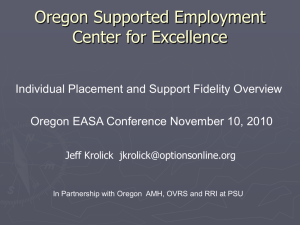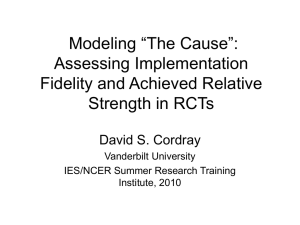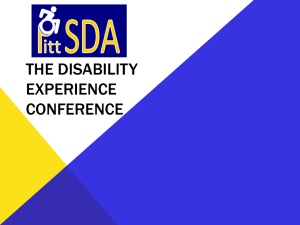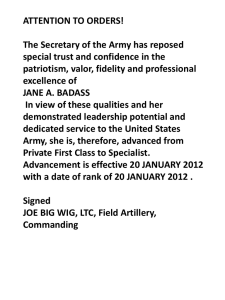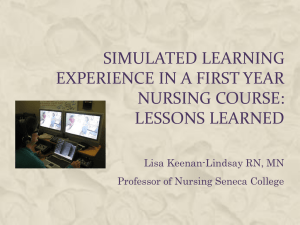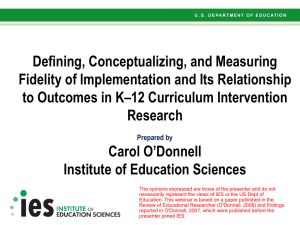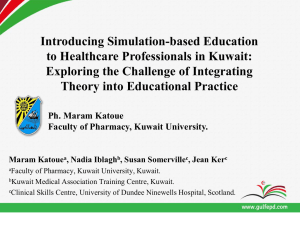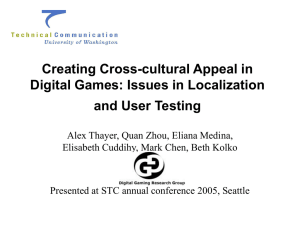Fidelity to what?
advertisement
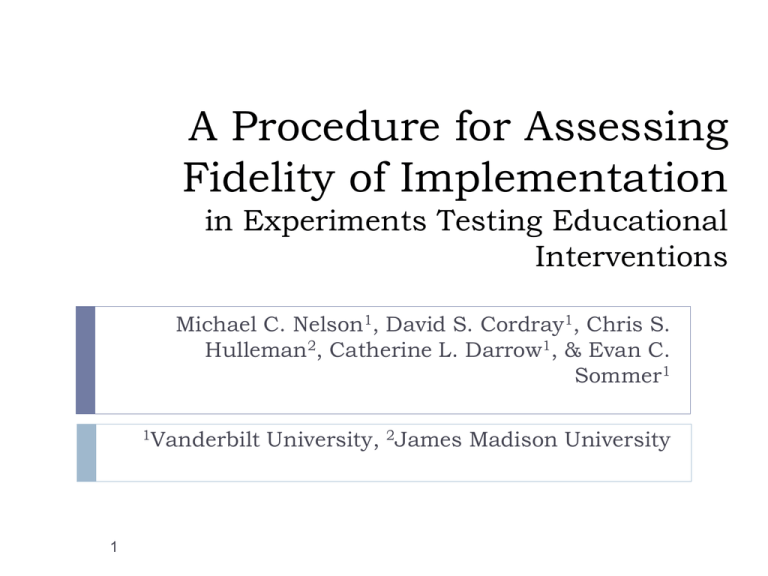
A Procedure for Assessing Fidelity of Implementation in Experiments Testing Educational Interventions Michael C. Nelson1, David S. Cordray1, Chris S. Hulleman2, Catherine L. Darrow1, & Evan C. Sommer1 1Vanderbilt 1 University, 2James Madison University Purposes of Paper: To argue for a model-based approach for assessing implementation fidelity To provide a template for assessing implementation fidelity that can be used by intervention developers, researchers, and implementers as a standard approach. 2 Presentation Outline I. What is implementation fidelity? II. Why assess implementation fidelity? III. A five-step process for assessing implementation fidelity IV. Concluding points 3 A Note on Examples: • Examples are drawn from our review of (mainly) elementary math intervention studies, which we are currently deepening and expanding to other subject areas • Examples for many areas are imperfect or lacking • As our argument depends on having good examples of the most complicated cases, we appreciate any valuable examples to which you can refer us (michael.nelson@vanderbilt.edu.) 4 What Is Implementation Fidelity? 5 What is implementation fidelity? Implementation fidelity is the extent to which the intervention has been implemented as expected Assessing fidelity raises the question: Fidelity to what? Our answer: Fidelity to the intervention model. Background in “theory-based evaluations” (e.g., Chen, 1990; Donaldson & Lipsey, 2006) 6 Why Assess Implementation Fidelity? 7 Fidelity vs. the Black Box The intent-to-treat (ITT) experiment identifies the effects of causes: Treatment “Black Box” Intervention’s Causal Processes Assignment to Condition Outcome Measures Outcomes Outcome Measures Control “Black Box” Business As Usual Causal Processes 8 Outcomes Fidelity vs. the Black Box …While fidelity assessment “opens up” the black box to explain the effects of causes: Intervention “Black Box” Assignment to Condition 9 Intervention Component Mediator Fidelity Measure 1 Fidelity Measure 2 Outcome Outcome Measure Fidelity assessment allows us to: Determine the extent of construct validity and external validity, contributing to generalizability of results 10 Fidelity assessment allows us to: Determine the extent of construct validity and external validity, contributing to generalizability of results For significant results, describe what exactly did work (actual difference between Tx and C) 11 Fidelity assessment allows us to: Determine the extent of construct validity and external validity, contributing to generalizability of results For significant results, describe what exactly did work (actual difference between Tx and C) For non-significant results, it may explain why beyond simply “the intervention doesn’t work” 12 Fidelity assessment allows us to: Determine the extent of construct validity and external validity, contributing to generalizability of results For significant results, describe what exactly did work (actual difference between Tx and C) For non-significant results, it may explain why beyond simply “the intervention doesn’t work” Potentially improve understanding of results and future implementation 13 Limitations of Fidelity Assessment: Not a causal analysis, but it does provide evidence for answering important questions 14 Limitations of Fidelity Assessment: Not a causal analysis, but it does provide evidence for answering important questions Involves secondary questions 15 Limitations of Fidelity Assessment: Not a causal analysis, but it does provide evidence for answering important questions Involves secondary questions Field is still developing and validating methods and tools for measurement and analysis 16 Limitations of Fidelity Assessment: Not a causal analysis, but it does provide evidence for answering important questions Involves secondary questions Field is still developing and validating methods and tools for measurement and analysis Cannot be a specific, one-size-fits-all approach 17 A Five Step Process for Assessing Fidelity of Implementation 1. 2. 3. 4. 5. Specify the intervention model Identify fidelity indices Determine index reliability and validity Combine fidelity indices* Link fidelity measures to outcomes* *Not always possible or necessary 18 Step 1: Specify the Intervention Model 19 The Change Model • A hypothetical set of constructs and relationships among constructs representing the core components of the intervention and the causal processes that result in outcomes 20 The Change Model • • A hypothetical set of constructs and relationships among constructs representing the core components of the intervention and the causal processes that result in outcomes Should be based on theory, empirical findings, discussion with developer, actual implementation 21 The Change Model • • • A hypothetical set of constructs and relationships among constructs representing the core components of the intervention and the causal processes that result in outcomes Should be based on theory, empirical findings, discussion with developer, actual implementation Start with Change Model because it is sufficiently abstract to be generalizable, but also specifies important components/processes, thus guiding operationalization, measurement, and analysis 22 Change Model: Generic Example 23 Intervention Component Mediator Outcome Teacher training in use of educational software Teachers assist students in using educational software Improved student learning Change Model: Project LINCS Instruction in geometry Increase in teacher knowledge of geometry Improved teacher instructional practice Instruction in student cognition of geometry Increase in teacher knowledge of student cognition Adapted from Swafford, Jones, and Thornton, 1997 24 The Logic Model The set of resources and activities that operationalize the change model for a particular implementation 25 The Logic Model The set of resources and activities that operationalize the change model for a particular implementation A roadmap for implementation 26 The Logic Model The set of resources and activities that operationalize the change model for a particular implementation A roadmap for implementation Derived from the change model with input from developer and other sources (literature, implementers, etc.) 27 Logic Model: Project LINCS Instruction in geometry Increase in teacher knowledge of geometry Geometry content course Improved teacher instructional practice What is taught How it is taught Instruction in student cognition of geometry Research seminar on van Hiele model Increase in teacher knowledge of student cognition Adapted from Swafford, Jones, and Thornton, 1997 28 Characteristics teachers display A Note on Models and Analysis: Recall that one can specify models for both the treatment and control conditions. The “true” cause is the difference between conditions, as reflected in the model for each. Using the change model as a guide, one may design equivalent indices for each condition to determine the relative strength of the intervention (Achieved Relative Strength, ARS). This approach will be discussed in the next presentation (Hulleman). 29 Steps 2 and 3: Develop Reliable and Valid Fidelity Indices and Apply to the Model 30 Examples of Fidelity Indices Self-report surveys Interviews Participant logs Observations Examination of permanent products created during the implementation process 31 Index Reliability and Validity Both are reported inconsistently Report reliability at a minimum, because unreliable indices cannot be valid Validity is probably best established from pre-existing information or side studies 32 Index Reliability and Validity Both are reported inconsistently Report reliability at a minimum, because unreliable indices cannot be valid Validity is probably best established from pre-existing information or side studies We should be as careful in measuring the cause as we are in measuring its effects! 33 Selecting Indices • Guided foremost by the change model: identify core components as those that differ significantly between conditions and upon which the causal processes are thought to depend 34 Selecting Indices • • Guided foremost by the change model: identify core components as those that differ significantly between conditions and upon which the causal processes are thought to depend Use the logic model to determine fidelity indicator(s) for each change component 35 Selecting Indices • • • Guided foremost by the change model: identify core components as those that differ significantly between conditions and upon which the causal processes are thought to depend Use the logic model to determine fidelity indicator(s) for each change component Base the number and type of indices on the nature and importance of each component 36 Selecting Indices: Project LINCS Change Model Construct Logic Model Indicators Indices None; Proposed:Teacher attendance, content delivery None; Proposed: Head count, observation Research seminar None; Proposed:Teacher van Hiele model attendance, content delivery None; Proposed: Head count, observation Components Instruction in geometry Geometry content course Instruction of student cognition of geometry Increase of teacher None knowledge of geometry Ability to apply geometry knowledge Pre/post test of geometry knowledge Increase of teacher knowledge of student cognition Improved teacher instructional practice None Ability to describe student cognition Pre/post test of van Hiele levels What is taught Alignment of lesson content with van Hiele levels Observations Improved teacher instructional practice How it is taught Particular instructional behaviors of teachers Observations Improved teacher instructional practice Characteristics teachers display Reflecting knowledge of student cognition in planning Lesson plan task Adapted from Swafford, Jones, and Thornton, 1997 37 Step 4: Combining Fidelity Indices* 38 Why Combine Indices? *May not be possible for the simplest models *Depends on particular questions 39 Why Combine Indices? *May not be possible for the simplest models *Depends on particular questions Combine within component to assess fidelity to a construct Combine across components to assess phase of implementation Combine across model to characterize overall fidelity and facilitate comparison of studies 40 Some Approaches to Combining Indices: • • Total percentage of steps implemented Average number of steps implemented 41 Some Approaches to Combining Indices: • • Total percentage of steps implemented Average number of steps implemented HOWEVER: These approaches may underestimate or overestimate the importance of some components! 42 Some Approaches to Combining Indices: • • Total percentage of steps implemented Average number of steps implemented HOWEVER: These approaches may underestimate or overestimate the importance of some components! • • Weighting components based on the intervention model Sensitivity analysis 43 MAP Example Weighting of training sessions for the MAP intervention Training Session Session 1 Month Content Initial Weight September Administration .25 Adjusted Weight .10 Session 2 October Data use .25 .30 Session 3 November .25 .50 Session 4 May Differentiated Instruction Growth and planning .25 .10 Cordray, et al (Unpublished) 44 Step 5: Linking Fidelity Measures to Outcomes* 45 Linking Fidelity and Outcomes • • • • • • *Not possible in (rare) cases of perfect fidelity (no covariation without variation) *Depends on particular questions Provide evidence supporting the model (or not) Identify “weak links” in implementation Point to opportunities for “boosting” strength Identify incorrectly-specified components of the model 46 Assessment to Instruction (A2i) Teacher use of web-based software for differentiation of reading instruction Professional developmentStudents use A2i Teachers use A2i recommendations for grouping and lesson planningStudents improve learning Measures: Time teachers logged in, observation of instruction, pre/post reading (Connor, Morrison, Fishman, Schatschneider, and Underwood, 1997) 47 Assessment to Instruction (A2i) Used Hierarchical Linear Modeling to analyze Overall effect size of .25 Tx vs. C Pooling Tx+C, teacher time using A2i accounted for 15% of student performance Since gains were greatest among teachers who both attended PD and were logged in more, concluded both components were necessary for outcome (Connor, Morrison, Fishman, Schatschneider, and Underwood, 1997) 48 Some Other Approaches to Linking from the Literature • • • • Compare results of hypothesis testing (e.g., ANOVA) when “low fidelity” classrooms are included or excluded Correlate overall fidelity index with each student outcome Correlate each fidelity indicator with the single outcome Calculate Achieved Relative Strength (ARS) and use HLM to link to outcomes 49 Concluding points 50 In Summary: If we do not know what we are testing, we cannot know what the results of our tests mean. 51 In Summary: If we do not know what we are testing, we cannot know what the results of our tests mean. Model-based (change and logic) assessment answers the question “Fidelity to what?” 52 In Summary: If we do not know what we are testing, we cannot know what the results of our tests mean. Model-based (change and logic) assessment answers the question “Fidelity to what?” There is a need for a systematic approach to fidelity assessment, which we describe 53 In Summary: If we do not know what we are testing, we cannot know what the results of our tests mean. Model-based (change and logic) assessment answers the question “Fidelity to what?” There is a need for a systematic approach to fidelity assessment, which we describe Most useful when research designs are able to incorporate this process from early stages 54 In Summary: If we do not know what we are testing, we cannot know what the results of our tests mean. Model-based (change and logic) assessment answers the question “Fidelity to what?” There is a need for a systematic approach to fidelity assessment, which we describe Most useful when research designs are able to incorporate this process from early stages Additional examples and refinement of measurement and analytical tools are needed 55 References Chen, H.T. (1990). Theory-driven evaluation. Thousand Oaks, CA: Sage Publications. Cohen, J. (1988). Statistical Power Analysis for the Behavioral Sciences, 2nd ed. Hillsdale, NJ: Erlbaum. Connor, C. M., Morrison, F. M., Fishman, B. J., Schatschneider, C., & Underwood, P. (2007). Algorithm-guided individualized reading instruction. Science, 315, 464-465. Cook, T. (1985). Postpositivist critical multiplism. In R. L. Shotland & M. M. Marks (Eds.), Social science and social policy (pp. 21-62). Beverly Hills, CA: Sage. Cordray, D.S. (2007) Assessing Intervention Fidelity in Randomized Field Experiments. Funded Goal 5 proposal to Institute of Education Sciences. Cordray, D.S., Pion, G.M., Dawson, M., and Brandt, C. (2008).The Efficacy of NWEA’s MAP Program. Institute of Education Sciences funded proposal. Donaldson, S.I., & Lipsey, M.W. (2006). Roles for theory in contemporary evaluation practice: Developing practical knowledge. In I. Shaw, J.C. Greene, & M.M. Mark (Eds.), The Handbook of Evaluation: Policies, Programs, and Practices (pp. 56-75). London: Sage. Fuchs, L.S., Fuchs, D., and Karns, K. (2001). Enhancing kindergarteners’ mathematical development: Effects of peer-assisted learning strategies. Elementary School Journal, 101, 495-510. Fuchs, L. S., Fuchs, D.,Yazdian, L, & Powell, S. R. (2002). Enhancing First-Grade Children's Mathematical Development with Peer-Assisted Learning Strategies. School Psychology Review, 31, 569-583. Gamse, B.C., Jacob, R.T., Megan, H., Boulay, B., Unlu, Fatih, Bozzi, L., Caswell, L., Rodger, C., Smith, W.C., Brigham, N., and Rosenblum, S. (2008). Reading First Impact Study Final Report. Washington, D.C.: Institute of Education Sciences. 56 References Ginsburg-Block, M. & Fantuzzo, J. (1997). Reciprocal peer tutoring: An analysis of teacher and student interactions as a function of training and experience. School Psychology Quarterly, 12, 1-16. Holland, P.W. (1986). Statistics and causal inference. Journal of the American Statistical Association.81(396), 945960. Hulleman, C. S., & Cordray, D. (2009). Moving from the lab to the field: The role of fidelity and achieved relative intervention strength. Journal of Research on Intervention Effectiveness, 2(1), 88-110. Hulleman, C.S., Cordray, D.S., Nelson, M.C., Darrow, C.L., & Sommer, E.C. (2009, June). The State of Treatment Fidelity Assessment in Elementary Mathematics Interventions. Poster presented at the annual Institute of Education Sciences Conference, Washington, D.C. Institute of Education Sciences (2004). Pre-doctoral training grant announcement.Washington, DC: US Department of Education. Knowlton, L.W. and Phillips, C.C. (2009). The Logic Model Guidebook: Better Strategies for Great Results. Washington, D.C.: Sage. Kutash, K., Duchnowski, A. J., Sumi, W. C., Rudo, Z. & Harris, K. M. (2002). A school, family, and community collaborative program for children who have emotional disturbances. Journal of Emotional and Behavioral Disorders, 10(2), 99-107. McIntyre, L.L., Gresham, F.M., DiGennaro, F.D., and Reed, D.D. (2007). Treatment integrity of school-based interventions with children in the Journal of Applied Behavior Analysis 1991-2005. Journal of Applied Behavior Analysis. 40, 659-672. 57 References Michalopoulos, C. (2005). Precedents and Prospects for Randomized Experiments. In H.S. Bloom (Ed.) Learning More from Social Experiments, (pp. 1-36). New York, NY: Russell Sage Foundation. Noell, G.H., Witt, J.C., Slider, N.J., Connell, J.E., Gatti, S.L., Williams, K.L., Koenig, J.L. & Resetar, J.L. (2005). Treatment Implementation Following Behavioral Consultation in Schools: A Comparison of Three Follow-up Strategies. School Psychology Review, 34(1), 87-106. O'Donnell, C. L. (2008). Defining, Conceptualizing, and Measuring Fidelity of Implementation and Its Relationship to Outcomes in K-12 Curriculum Intervention Research. Review of Educational Research, 78(1), 33-84. Shadish,W.R., Cook, T.D., and Campbell, D.T. (2002). Experimental and Quasi-Experimental Designs for Generalized Causal Inference. New York, NY: Houghton Mifflin Company. Swafford, J.O., Jones, G.A., and Thornton, C.A. (1997). Increased Knowledge in Geometry and Instructional Practice. Journal for Research in Mathematics Education, 28(4), 467- 483. Trochim, W. and Cook, J. (1992). Pattern matching in theory-driven evaluation: A field example from psychiatric rehabilitation. In H. Chen and P.H. Rossi (Eds.) Using Theory to Improve Program and Policy Evaluations. Greenwood Press, New York, 49-69. 58
